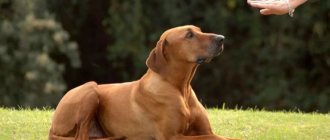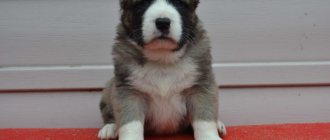Self-control, or maintaining stillness in a certain position, is a rather useful skill. How to teach a dog the “Wait” command is explained during the passage
UGSAndOKD– basic obedience courses. Despite this, the owner himself can do the training, because he does not need any special skills to conduct classes. If you are determined to learn on your own, then you need to understand the basics: the algorithm of actions and possible difficulties.
The need for a team
At dog shows, endurance is used in conjunction with the skills “Sit”, “Lie down” and “Place”. Once in the desired position, the pet must maintain it for 15 or 30 seconds.
In everyday life, complete immobility is not important. The main emphasis is on waiting, that is, the dog simply remains where it was left and ignores the irritants.
This skill is used when tying in front of a store and in other situations when the owner is forced to leave temporarily. In a free position, the waiting time can reach 15 minutes or more if the animal has a strong and balanced psyche.
At what age should we teach “Wait”?
The command should be taught from 6-7 months. The dog is fully ready for training by 9 months. Of course, a 1 month old puppy will not be able to fulfill this order from the owner. He will not be able to do this at 2 or 3 months, or even at 4-5 months of age.
Before studying this command, any dog trainer will advise teaching the dog to “lie down” and “sit”.
It is worth remembering that beagle, spaniel, corgi, pug, bulldog and sharpei puppies will learn commands faster due to their calm temperament. Doberman, Labrador, Yorkie, Pekingese, Poodle, Dachshund, Toy Terrier, Husky, Chihuahua and Spitz puppies will take longer to learn the command. This may require behavior correction, which is usually carried out by a canine psychologist. After all, these breeds have a naturally violent temperament.
Basic Skills
During training, a contrasting method is used, combining coercion and encouragement. For mutual understanding, by the time of training the pet must know the following commands:
- "Sit", "Lie" and "Place" required for coercion;
- “Walk” and “Come to me”, used as a reward;
- “Do not” helps to correct incorrect actions.
When working with restless animals, it is better to use only “Walk”. Otherwise, they will be very worried, preparing to run up to the owner.
After consolidating the skill, you can use your own return as a reward. In this case, the four-legged animal will be calm until the moment you leave the store.
Character
Akita Inu are independent and thinking dogs. They will not obey just because the owner has declared himself the leader of the pack family. You must love your pet and earn his respect. Then he will respond with loyalty and sincere obedience.
Otherwise, Akita Inus are friendly and balanced. They love family members and are patient with small children. If a puppy grows up in a home with other animals, he will be loyal to them.
Akitas are wary of strangers, but not aggressive. In an extreme situation, they will not rush into battle: first they assess the situation, and then protect the owner.
Akitas are able to adapt to the owner's lifestyle. This breed is suitable for both a large family and a single person.
How to teach a dog the “Wait” command in three steps
For training, you need to choose a quiet and fenced place without thick grass that impairs the animal’s view. The most convenient option is an empty dog park. Distraction by extraneous factors can only be added at the very last stage, so be sure to make sure that there are no other four-legged animals, people or vehicles nearby.
Meet the team
At this stage, it is necessary to achieve understanding of the voice command. More complex elements will be dealt with later.
When you reach a dog park or other safe area, command “Sit” or “Lie down” and, after waiting for your pet to sit or lie down, say the word “Wait”.
Wait about 10 seconds, and then be sure to praise your pet if he doesn’t go anywhere, and let him go with the words “Walk” or “Come.” Once you have achieved understanding and correct execution, try increasing the distance. To do this, repeat the previous steps and slowly move back a few steps while the dog is still in place.
At first, it is better to move far away and not lose eye contact. About 15 meters will be enough. You shouldn’t go too far with the exposure time. Proceed to the next stage when you manage to increase it to 1-2 minutes.
IMPORTANT!
Do not conduct more than 3 classes a day and be sure to take breaks of 5-7 minutes between them.
Training for endurance
After getting acquainted, all that remains is to figure out how to teach a dog long endurance and a calm reaction to stimuli. At this stage, the waiting time gradually increases to 10 minutes while maintaining a distance of 15 meters.
Constant eye contact is also eliminated. Otherwise, the pet may associate execution with the fact of control and slack when you are not looking at it.
Sit your dog down, command “Wait” and walk away a few steps. Turn half sideways or straight with your back and squat down on the ground. Try picking flowers or just pretend to be busy.
Be sure to glance at your pet out of the corner of your eye. If he starts to fuss, loudly and clearly repeat the word “Wait” without changing your position, and if not, wait the right time, return to your pet, praise him and let him go with “Walk.”
Having secured the ability to turn away, try changing your step: increase your usual speed or start running. The owner's retreat at a fast pace is the hardest for animals, so be patient and have some free time.
Practicing a skill in different situations
At this stage, the absence of the owner and various distractions are added. Command “Wait”, go to the nearest tree or house and hide.
Most four-legged animals are very worried about the disappearance of the owner, so at first hide for only 5 seconds. If you release your pet with the phrase “Come to me,” then say it only when you come out of hiding.
Having achieved a calm wait for 5 minutes, diversify your training with the presence of strangers. In unusual conditions, the dog will work worse and may make mistakes, so it will be easier for him to start from the basics. There is no need to be afraid of this, because the animal already has a direct understanding of the expectations placed on it.
To maintain a skill, you need to constantly practice it. You can use it when pouring food to prevent your pet from eating until given permission. Another possible option is to get out of the car. If the four-legged dog faithfully waits inside, then you can unload the trunk completely calmly.
Summarizing
Please note that during initial training, the optimal number of repetitions of the exercise per day is 2-3 times. According to the increase in distance and endurance, you can reduce the number of training sessions. When your pet begins to perform this command perfectly, it is recommended to repeat it every week so that he does not forget it. Do not forget that training should take place in quiet places where nothing will frighten the dog.
If you want to make the exercise more challenging, you can practice on an area where there are other animals. Each training session should be carried out calmly and without raising your voice, so as not to frighten your pet. Be sure to praise him after completing the command. It is very important to remember that if your pet does not yet fully comply with this command, or is afraid, then it is forbidden to carry out training in crowded or noisy places.
You should not leave your pet alone on the street; if you need to step away for a few minutes, the dog should be “in sight” so that you can be sure that passers-by are not approaching it and not scaring it. Moreover, someone may try to steal your pet or lure it somewhere with a treat. Therefore, no matter how well trained your pet is, do not leave him alone.
By paying attention and devoting your personal time, you can train your pet without much difficulty, but paying attention to the fact that it is not so easy to execute this command, and the puppy does not understand what is required of him, you can turn to specialists. Professional dog trainers will be able to competently and quickly train your pet, and he will perfectly carry out this command. The main thing is to find an experienced specialist who will not force the dog or frighten it, but will be able to find an approach and explain what needs to be done.
Error correction
When leaving the place, use the word “No” and independently return the dog to its original position. Don't try to shout "Place", because this word is necessary for the initial landing. Also, you should not use “To me”, so as not to cause confusion with prohibition and encouragement.
If your pet makes mistakes more and more often, return to the previous stage, reducing the distance or duration of waiting. Remember that the "Wait" command requires strong self-control. Don't demand too much from your pet and let him go at his own pace, without adjusting to other people's expectations.
Do you like the article? 0
Reward good behavior
In the early stages of learning, encourage any hesitation. If you command your dog to “wait” and he lunges forward, praise him and open the door. When opening the door, use a command that lets her know that moving forward is allowed, such as “ok” or “forward.”
Once your dog begins to truly “wait” on command, make him wait a couple more seconds before releasing him.
Once your pet is able to remain motionless for a few seconds or longer, you can begin to open the door a little wider. However, you must be prepared to close it quickly in case your dog tries to escape.
Akita Inu training: general recommendations
The process of raising an Akita Inu must be organized taking into account the pet’s character traits.
Duration of training
Basic commands should be taught in 3-4 repetitions. However, this rule does not apply to the commands “Come to me!” and “Nearby.” It is better to repeat them 5-6 times a day in any convenient situations (when feeding, if you want to pet the dog, etc.).
If the dog does not want to do what is required, there is no need to insist. It is necessary to deprive him of the treat and begin to practice another skill.
Reward and Punishment
It is better to encourage your Akita with affection or treats. For the latter, finely chopped pieces (in cubes no larger than 1.5 cm) of food that the dog loves very much, but receives infrequently, are suitable. For example, cheese or meat. The size of the treat should be such that the puppy is not distracted by chewing.
Akita Inu cannot be punished. This breed is too proud. She will not tolerate such treatment. To show dissatisfaction, it is better to deprive the dog of attention for a while.
Prohibitions for Akita Inu
Akitas can be aggressive towards other animals. Therefore, unwanted behavior must be stopped immediately.
It is also necessary to explain to the puppy that it is forbidden to bite people.
Important! You cannot train an Akita Inu to attack people. This can cause the dog to feel superior, coupled with aggression.
Akita Inu and baiting
It is better to start training an Akita Inu from the age of one and a half years. It is important that the dog already clearly follows basic commands.
Baiting is organized at special hunting bases, where animals are kept on a leash. The dog must find prey by scent trail. Only after this is he brought to the game, encouraging excitement and aggression.
It is better not to carry out such an operation for a novice hunter. It is advisable to trust an experienced dog handler who specializes specifically in Akita Inu.
Akita Inu and guard duty
Often people get large dogs expecting them to be good guards. However, in the case of the Akita, it is worth remembering that this is primarily a hunting breed.
Of course, she will do everything to protect the owner in an extreme situation. But encouraging attacks on other people can make an Akita Inu an uncontrollable aggressor. The dog may begin to attack anyone who approaches its territory.
Therefore, the owner’s task is to teach the pet to vocalize if someone comes to visit. It is optimal if the Akita sees this from the example of an older tribesman. If it is impossible to organize this, it is worth simulating the situation with the help of friends.











